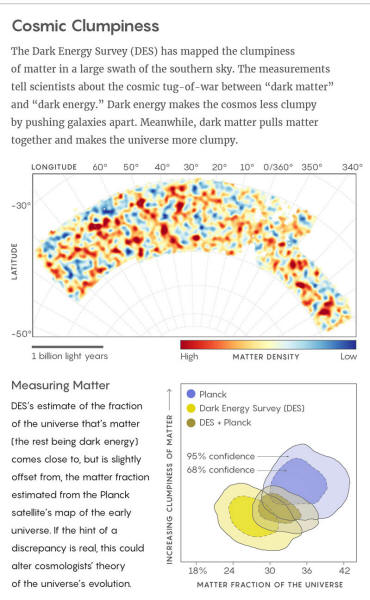|
by Natalie Wolchover from QuantaMagazine Website
density map: Chihway Chang, Dark Energy Survey collaboration;
sky image: Axel Mellinger.
In a much-anticipated analysis of its first year of data, the Dark Energy Survey telescope experiment has gauged the amount of dark energy and dark matter in the universe by measuring the clumpiness of galaxies - a rich and, so far, barely tapped source of information that many see as the future of cosmology.
The analysis, posted on DES's website today and based on observations of 26 million galaxies in a large swath of the southern sky, tweaks estimates only a little.
It draws the pie chart of the universe as 74 percent dark energy and 21 percent dark matter, with galaxies and all other visible matter - everything currently known to physicists - filling the remaining 5 percent sliver.
The results are based on data from the telescope's first observing season, which began in August 2013 and lasted six months.
Since then, three more rounds of data collection have passed; the experiment begins its fifth and final planned observing season this month.
As the 400-person team analyzes more of this data in the coming years, they'll begin to test theories about the nature of the two invisible substances that dominate the cosmos - particularly dark energy,
Already, with their first-year data, the experimenters have incrementally improved the measurement of a key quantity that will reveal what dark energy is.
Both terms - dark energy and dark matter - are mental place holders for unknown physics.
The balance of the two unknown substances sculpts the distribution of galaxies.
The Dark Energy Survey uses a 570-megapixel camera mounted on the Victor M. Blanco Telescope in Chile (left). The camera is made out of
74 individual light-gathering wafers (right).
A Dark Map
Until now, the best way to inventory the cosmos has been to look at the "cosmic microwave background":
Cosmic microwaves come from the farthest point that can be seen in every direction, providing a 2-D snapshot of the universe at a single moment in time, 380,000 years after the Big Bang (the cosmos was dark before that).
Planck's map of this light shows an extremely homogeneous young universe, with subtle density variations that grew into the galaxies and voids that fill the universe today.
Galaxies, after undergoing billions of years of evolution, are more complex and harder to glean information from than the cosmic microwave background.
But according to experts, they will ultimately offer a richer picture of the universe's governing laws since they span the full three-dimensional volume of space.
To obtain that information, the DES team scrutinized a section of the universe spanning an area 1,300 square degrees wide in the sky - the total area of 6,500 full moons - and stretching back 8 billion years (the data were collected by the half-billion-pixel Dark Energy Camera mounted on the Victor M. Blanco Telescope in Chile).
They statistically analyzed the separations between galaxies in this cosmic volume.
They also examined the distortion in the galaxies' apparent shapes - an effect known as "weak gravitational lensing" that indicates how much space-warping dark matter lies between the galaxies and Earth.
These two probes - galaxy clustering and weak lensing - are two of the four approaches that DES will eventually use to inventory the cosmos.
Already, the survey's measurements are more precise than those of any previous galaxy survey, and for the first time, they rival Planck's.
With DES's first-year data,
For cosmologists, the key question was whether DES's new cosmic pie chart based on galaxy surveys would differ from estimates of dark energy and dark matter inferred from Planck's map of the cosmic microwave background.
Comparing the two would reveal whether cosmologists correctly understand how the universe evolved from its early state to its present one.
The DES scientists spent six months processing their data without looking at the results along the way - a safeguard against bias - then "unblinded" the results during a July 7 video conference.
After team leaders went through a final checklist, a member of the team ran a computer script to generate the long-awaited plot:
Planck pegged matter at 33 percent of the cosmos today, plus or minus two or three percentage points.
When DES's plots appeared, applause broke out as the bull's-eye of the new matter measurement centered on 26 percent, with error bars that were similar to, but barely overlapped with, Planck's range.
Statistically speaking, there's only a slight tension between the two results:
The mismatch stands out to the eye, but for now, Joshua Frieman and his team consider their galaxy results to be consistent with expectations based on the cosmic microwave background.
Whether the hint of a discrepancy strengthens or vanishes as more data accumulate will be worth watching as the DES team embarks on its next analysis, expected to cover its first three years of data.
If the possible discrepancy between the cosmic-microwave and galaxy measurements turns out to be real, it could create enough of a tension to lead to the downfall of the "Lambda-CDM model" of cosmology, the standard theory of the universe's evolution.
Lambda-CDM is in many ways a simple model that starts with Albert Einstein's general theory of relativity, then bolts on dark energy and dark matter.
A replacement for Lambda-CDM might help researchers uncover the quantum theory of gravity that presumably underlies everything else.
What Is Dark Energy?
According to Lambda-CDM, dark energy is the "cosmological constant," represented by the Greek symbol lambda in Einstein's theory; it's the energy that infuses space itself, when you get rid of everything else.
This energy has negative pressure, which pushes space away and causes it to expand.
New dark energy arises in the newly formed spatial fabric, so that the density of dark energy always remains constant, even as the total amount of it relative to dark matter increases over time, causing the expansion of the universe to speed up.
The universe's expansion is indeed accelerating, as two teams of astronomers discovered in 1998 by observing light from distant supernovas.
The discovery, which earned the leaders of the two teams the 2011 Nobel Prize in physics, suggested that the cosmological constant has a positive but "mystifyingly tiny" value, Gary Bernstein said.
On the other hand, dark energy could be something else entirely.
Frieman, whom colleagues jokingly refer to as a "fallen theorist," studied alternative models of dark energy before co-founding DES in 2003 in hopes of testing his and other researchers' ideas.
The leading alternative theory envisions dark energy as a field that pervades space, similar to the "inflaton field" that most cosmologists think drove the explosive inflation of the universe during the Big Bang.
The slowly diluting energy of the inflaton field would have exerted a negative pressure that expanded space, and Frieman and others have argued that dark energy might be a similar field that is dynamically evolving today.
DES's new analysis incrementally improves the measurement of a parameter that distinguishes between these two theories - the cosmological constant on the one hand, and a slowly changing energy field on the other.
If dark energy is the cosmological constant, then the ratio of its negative pressure and density has to be fixed at −1.
Cosmologists call this ratio w.
If dark energy is an evolving field, then its density would change over time relative to its pressure, and w would be different from −1.
Remarkably, DES's first-year data, when combined with previous measurements, pegs w's value at −1, plus or minus roughly 0.04.
However, the present level of accuracy still isn't enough to tell if we're dealing with a cosmological constant rather than a dynamic field, which could have w within a hair of −1.
The DES scientists will tighten the error bars around w in their next analysis, slated for release next year; they'll also measure the change in w over time, by probing its value at different cosmic distances. (Light takes time to reach us, so distant galaxies reveal the universe's past).
If dark energy is the cosmological constant, the change in w will be zero. A nonzero measurement would suggest otherwise.
Larger galaxy surveys might be needed to definitively measure w and the other cosmological parameters.
In the early 2020s, the ambitious Large Synoptic Survey Telescope (LSST) will start collecting light from 20 billion galaxies and other cosmological objects, creating a high-resolution map of the universe's clumpiness that will yield a big jump in accuracy.
The data might confirm that we occupy a Lambda-CDM universe, infused with an inexplicably tiny cosmological constant and full of dark matter whose nature remains elusive.
But Frieman doesn't discount the possibility of discovering that dark energy is an evolving quantum field, which would invite a deeper understanding by going beyond Einstein's theory and tying cosmology to quantum physics.
|





